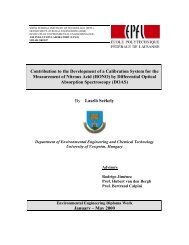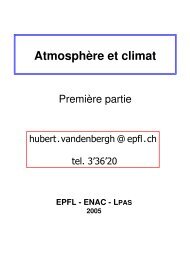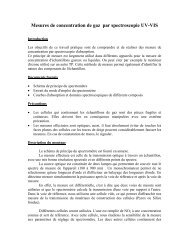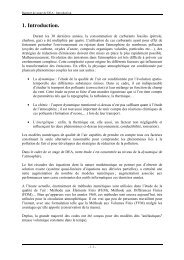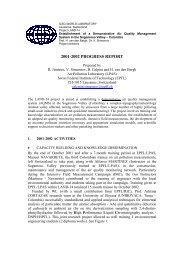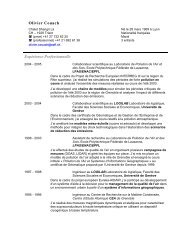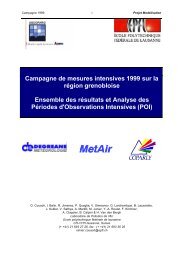Diploma report Implementation and verification of a simple ... - LPAS
Diploma report Implementation and verification of a simple ... - LPAS
Diploma report Implementation and verification of a simple ... - LPAS
You also want an ePaper? Increase the reach of your titles
YUMPU automatically turns print PDFs into web optimized ePapers that Google loves.
4.2 Hydrostatic balance<br />
Hydrostatic equilibrium in vertical direction z can be computed using equation (60). However,<br />
even if the initial pressure is analytical, there will be small numerical imprecisions due<br />
to discretization into finite volumes. Indeed, the pressure is generally not a linear function<br />
<strong>of</strong> height <strong>and</strong> small errors arise when approximating average values over each cells. These<br />
imprecisions then lead to the creation <strong>of</strong> winds at the beginning <strong>of</strong> the simulation. The maximum<br />
velocity <strong>of</strong> these winds then increases to stabilise at a constant mean value around<br />
which it oscillates with time.<br />
This behaviour is due to the integration schemes themselves <strong>and</strong> their associated local<br />
truncation error. In order to obtain good results, numerical filters are used that smooth the<br />
solutions <strong>and</strong> therefore reduce the wind velocities. Sensitivity tests to filtering using hydrostatic<br />
equilibrium in one dimension were done. The results are presented on semilogarithmic<br />
plots <strong>of</strong> |w| max versus time, where |w| max is the maximum <strong>of</strong> z-velocity values over the whole<br />
domain. The plots are shown in Figure 4 <strong>and</strong> Figure 5. The model is integrated using a<br />
Leapfrog scheme together with centered-in-space differences <strong>and</strong> the boundary conditions are<br />
a solid wall with background.<br />
The models using a Leapfrog scheme afford an undamped computational mode that leads<br />
to the creation <strong>of</strong> oscillations <strong>and</strong> instabilities in the solution. These unwanted effects can<br />
be controlled by applying an Asselin time filter after each step (see section 3.4.2). The value<br />
<strong>of</strong> the filter coefficient µ must be chosen so that the filter strongly damps the computational<br />
mode while having only little impact on the physical mode. A series <strong>of</strong> simulations is done for<br />
various values <strong>of</strong> µ <strong>and</strong> the results are shown in Figure 4. It is observed that the amplitude<br />
<strong>of</strong> the oscillations are reduced as µ is increased. However, at the same time, the average<br />
value <strong>of</strong> |w| max increases a little bit. This can be seen by comparing the plots with time<br />
filter constants <strong>of</strong> 0.05 <strong>and</strong> 0.4 in Figure 4. Although the curve for µ = 0.4 is smoother, it<br />
is also higher, meaning that the velocities are bigger. With very large values <strong>of</strong> µ (e.g. 0.6),<br />
the velocities even continuously increase with time to reach values <strong>of</strong> 10 −3 ms −1 after 9000 s.<br />
Filter coefficients µ in the range 0.05 - 0.2 will be used in our model.<br />
A second order spatial filter as given by (71) can be used to damp the 2∆x-scale noise<br />
generated by numerical dispersion. Results for different values <strong>of</strong> the filter coefficient ν are<br />
presented in Figure 5 showing that the velocities can be reduced by increasing the strength <strong>of</strong><br />
the filter. However, beside reducing the 2∆x noise, the filtering may also act on longer wave<br />
components, which does contain physical meaningful information <strong>and</strong> therefore should not<br />
be affected by the filter. In the last plot <strong>of</strong> Figure 5, the decrease <strong>of</strong> |w| max with time seems<br />
to indicate that these longer wave components are smoothed by the filter. A very strong filter<br />
may therefore create too much diffusion <strong>and</strong> lead to the loss <strong>of</strong> physical information. For<br />
this reason the strength <strong>of</strong> the filter should be adapted according to the problem being solved.<br />
Sensitivity to source term formulation is also tested <strong>and</strong> is presented in Figure 6. Three<br />
different techniques for the interpolation <strong>of</strong> ρ are compared: Midpoint, Simpson rule over<br />
one cell <strong>and</strong> Simpson rule over two cells. In Midpoint, the average cell value <strong>of</strong> ρ is used to<br />
compute the source term, leading to a first order approximation. The value <strong>of</strong> the source term<br />
24



